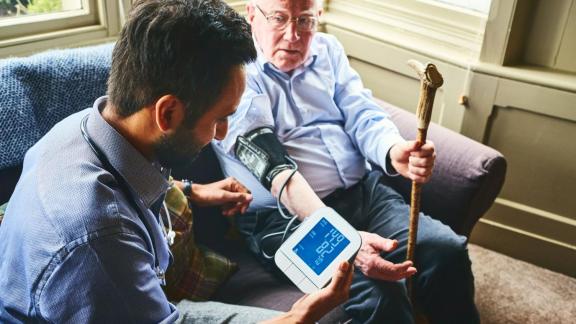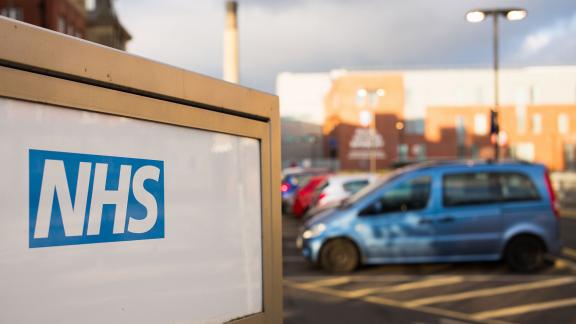NHS Reset: A catalyst for change? How the experience of the pandemic will shape community provision in future

NHS Reset is an NHS Confederation campaign to help shape what the health and care system should look like in the aftermath of the pandemic.
In this blog, part of a series of comment pieces from NHS Confederation members and partners, Andrew Ridley, chair of the Community Network, considers community providers’ pivotal response to the pandemic and considers whether this could be the trigger to give NHS community health services the resources and recognition they need.
Keeping patients well outside of a hospital setting and getting them home as soon as possible once they are medically fit delivers benefits both to the individual and to the health and care system. Community providers and their staff proved pivotal in supporting the NHS’s response to the pandemic, keeping acute beds free, helping to discharge thousands of patients safely into the community and moving services online. While repeated government and national commitments to developing community capacity have failed to deliver, could the pandemic be a catalyst for change?
How do we ensure NHS community health services receive the recognition and resources they need to make this rhetoric reality?
At the forefront of the COVID-19 response
The COVID-19 pandemic has challenged NHS community health services on an unprecedented scale. Yet look how they have risen to that challenge. We’ve seen how rapidly community providers freed up over 30,000 hospital beds for the initial peak of COVID-19 cases after funding and regulatory barriers were lifted. Community providers worked with local partners to reduce bed occupancy from over 95 per cent down to 50 per cent in some hospitals, with most patients going back home with support from community and social care, where needed.
We’ve also seen how expertly they flexed their service provision to support more patients with more complex needs at home than ever before. In some of the best-performing areas, over 90 per cent of patients are now discharged back home, with rapid response and intermediate care teams providing extra support where necessary. This has brought forward the NHS Long Term Plan ambition to deliver more care closer to home.
These achievements are all the more impressive when seen in the context of pre-COVID-19 challenges, including a growing gap between capacity and demand, workforce shortages and funding constraints on the NHS and local authorities.
This degree of transformation also took place against a backdrop of unique operational challenges. With testing capacity limited, community staff unfortunately found themselves at the back of the queue for testing in the initial weeks of the pandemic according to national policy guidelines. Access to PPE was particularly challenging for organisations outside of the NHS trust supply chain. Providers also became frustrated with the absence of national demand and capacity modelling for the community sector, and felt while guidance was often understandably focused on acute hospitals, tailored support for the community sector was much slower to arrive. These are all challenges that providers and colleagues in the national bodies can and must learn from to ensure preparedness for future pandemics, or indeed for a second wave of COVID-19.
What next for NHS community health services?
In the short term, like their colleagues across health and care systems, community service providers need to manage COVID-19 and non-COVID-19 demand, at the same time as restarting essential services like immunisation programmes quickly and embedding digital transformation and workforce flexibility. They are also looking ahead to winter and the parallel risks of a bad flu season and potential second wave of COVID-19. Their leaders are clear: the next few months will be even more challenging than those just passed.
NHS community health services now face a ‘long tail’ of tens of thousands of patients who have suffered the most severe effects of COVID-19 and need post-discharge rehab care. The recent announcement of a new digital Your COVID Recovery service shows the government’s recognition of this pressure. But it’s unclear how this will fit in with local community service provision.
The community sector relied on low bed occupancy in acute hospitals to absorb some demand over the past few months. This will not be possible during winter, so we need to review community rehabilitation services in the round and ensure there is adequate supply of home-based rehab services and sufficient rehab beds for the minority of patients who need them. We also need to bring the same rigour of planning to community care that we do to acute activity planning.
While the Seacole centre model works well in some local areas, such as Surrey Downs, the government needs to look beyond bedded care and invest in community capacity across the board. This expansion of community services needs to focus on preventing future demand, as well as meeting current demand, and ensure that people are only in an NHS community bed until they can safely be in their own. Otherwise the pre-COVID-19 demand and capacity gap will continue to grow.
While the recent announcement of £500m discharge to assess funding for the rest of the year was welcome, the government needs to go much further to make the rhetoric about expanding community care a reality.
What does the future look like for NHS community health services?
The pandemic highlights the need for better nationally comparable data. Delays in referrals and access to treatment are currently less visible in national performance data sets and to the public in the community sector than for other services such as A&E, elective or cancer care. It seems likely that the two-hour community crisis response and two-day reablement care standards in the NHS Long Term Plan will be brought forward. This will help to raise the profile of the community sector at a national level but must be supported by sustainable funding, national infrastructure and increased workforce to deliver the aspirations behind the targets.
Taking a longer-term view, the NHS Long Term Plan Bill looms large on the horizon, with community service providers keen to make their voices heard on key issues such as ending frequent competitive tendering for contracts. The future of integrated care systems is also on the table and community services want to keep the focus on integrated patient pathways rather than yet more structural change. Similarly, the new PCN contract must facilitate true and open collaboration and integration between primary and community care services.
It will also be interesting to see how public preferences are impacted in the longer term by COVID-19. Far more people with non-COVID conditions are choosing to receive care in their own home rather than in hospital or a care home, as the risk of picking up infections including COVID-19 is lower. This could lead to a permanent reduction in non-COVID inpatient admissions and necessitate increased capacity in hospital at home services. A real catalyst for reimagining the NHS at home and shifting more care into the community.
Andrew Ridley is chair of the Community Network, which was established by the NHS Confederation and NHS Providers. He is also the chief executive of Central London Community Healthcare NHS Trust.
This op-ed was first published in the BMJ.
The Community Network published a report on 4 August on the impact of COVID-19 on NHS community health services.



